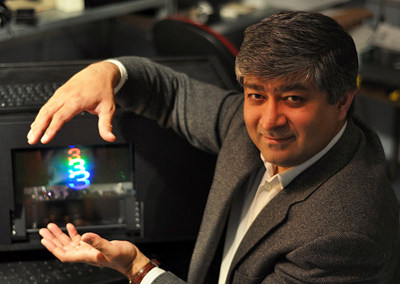12 Sep 2016
A holographic ‘roadmap’ of the inner body in the most intricate detail so far; for research and teaching.
Holoxica, the holographic 3D visualisation company, has created holographic 3D digital Human Anatomy “Atlas” prototype, said to be a realistic depiction of deeper human anatomical structures. The company says it will give teaching hospitals, medical schools, colleges and research centers “a detailed interpretation and perspective of intricate anatomical structures”.The Holographic 3D anatomy atlas is a joint collaboration between Holoxica and Professor Gordon Findlater, Professor of Translation Anatomy at The School of Biomedical Sciences, the University of Edinburgh.
The Atlas resembles a book, with physical pages that can be turned, and with an integrated light. The light is used to bring out the holographic images, which look spectacular as they seem to emerge from the page in full-color 3D.
The hologram is explained on the facing page of the 3D “atlas” using 2D illustrations. The image data used to create it has been sourced from CT, MRI, and ultrasound scans and specially-created 3D models to replicate a true three-dimensional understanding of the underlying anatomy.
’Fresh perspective’
Dr Javid Khan, CEO, Holoxica, commented, “biomedical science now has access to a tool that gives trainee surgeons and clinicians a fresh perspective into identifying, diagnosing and treating a wide range of conditions like never before.
He added, “Medical students have often struggled with a deeper understanding of the relative positioning of complex anatomical structures, for example, the location of a vein in front of a nerve, which might be located behind a tendon.

Holoxica's Dr Javid Khan.
Digital holograms contain a vast amount of information – a square millimetre holds around 24 Mbytes of data, which corresponds to all of the rays of light emitting from every direction to form a 3D image. By comparison, a typical smartphone has less than a thousand bytes of information in the same area. The holograms are manufactured using a special holographic printing machine, which is used to make a master hologram. The master is then replicated with no loss of resolution or quality and the 3D Atlas takes shape from there.”
Holoxica is hoping that the 3D Anatomy Atlas will be used by universities worldwide as a teaching aid for first and second year medical and anatomy students. For them, the challenge is understanding the true 3D nature of the underlying anatomy, so solving this issue will save considerable time and effort. The company sates that feedback from students and teachers has been positive; “with one Professor of Anatomy saying that this technology would have saved him months of study whilst he was an undergraduate”.
Dr Khan said, “Collating all this incredible data and developing the 3D Atlas is a natural progression for us”, says Dr Khan. “Every hologram image is illustrated and annotated on the opposite page of the atlas which contains 11 pages and 13 holograms. All but one of these pages contains a ‘channelling’ feature which enables the viewer to move around the hologram and see directly ‘inside’ organs where different layers are stripped away.”
Holoxica is teaming up with Scion Publishing, a renowned medical publisher, and Zebra Imaging, a manufacturer of digital holograms, to transform the 3D Anatomy Atlas prototype into a commercial product. Holoxica is also conducting research into a holographic 3D video display, designed to view images in real-time as they are produced by medical scanners. This project has support from the EU Horizon2020 SME Instrument Programme.
| © 2024 SPIE Europe |
|